Japan
Wood Products Prices
Dollar Exchange Rates of 10th
September 2017
Japan Yen 109.39
Reports From Japan
Geopolitical risks undermine
sentiment
Cabinet Office data shows that consumer sentiment
weakened in August with the consumer confidence index
falling to 43.3 from 43.8 in July. All four components of
the indicator declined from July.
The overall livelihood indicator fell, likewise, consumer
views on income growth deteriorated in August and the
indicator for employment also declined. Of particular
interest to the furniture sector was the decline in
consumers’ willingness to buy durable goods.
In contrast, Japan’s manufacturing PMI in August rose
slightly but was below analyst’s expectations. The
improvement in manufacturing was mainly attributed to an
improvement in both domestic and international demand.
However, while a recovery in global demand is helping
Japan’s economy the risk of conflict in North Korea is
impacting business sentiment.
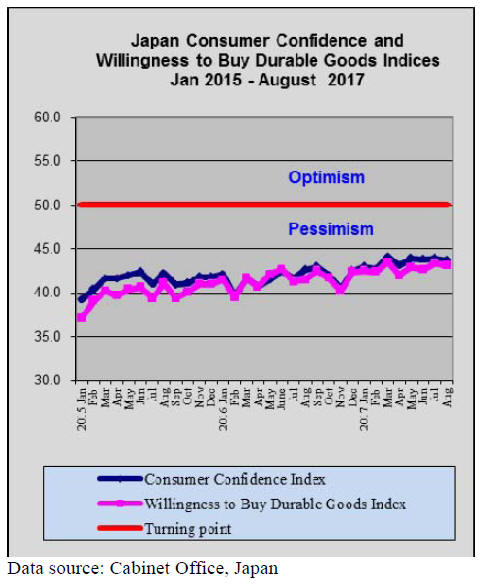
Yen buffeted by storms and North Korea
Early September was a turbulent month for the yen. The
impact of hurricane Irma on the US/yen exchange rate was
immediate. At one stage the yen was 107 to the dollar but
the dollar quickly recovered.
As if violent storms were not enough, North Korea fired a
missile over northern Japan and then conducted a massive
nuclear bomb test but despite these events the yen
remained in demand. But, there are some questioning how
long the yen will retain its safe-haven status. If conflict in
the region escalates there will be a major re-alignment of
exchange rates.
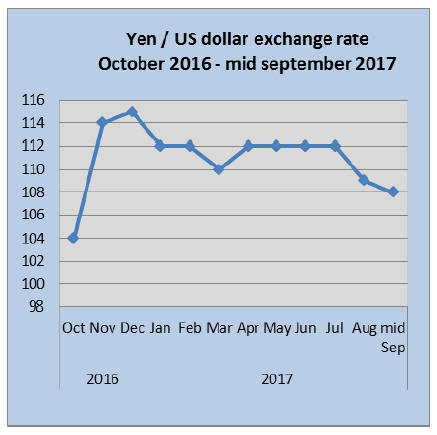
Re-tech, technology applied to home valuations
Selling a home in Japan can be a nightmare. Traditionally
newly built homes in Japan depreciate at a startling rate, It
is not uncommon for a new home to be valued at around
half of the original cost within a few years.
Part of this problem is the reliability of
valuations of
secondhand homes. Valuing a home is most commonly
done by appraisal companies and in many cases their
assessment methods are specific to their own interests
such that assessed values can be inconsistent or out of
touch with market reality.
Home sellers in Japan now have an alternative means to
get their home valued – Re-tech, short for real estate
technology, which uses software to access huge amounts
of data to forecast the current and future prices of
secondhand homes.
Analysts in the housing sector say Re-tech technologies
may be of help in addressing the problem of the 8 million
or more vacant and unsaleable homes in Japan.
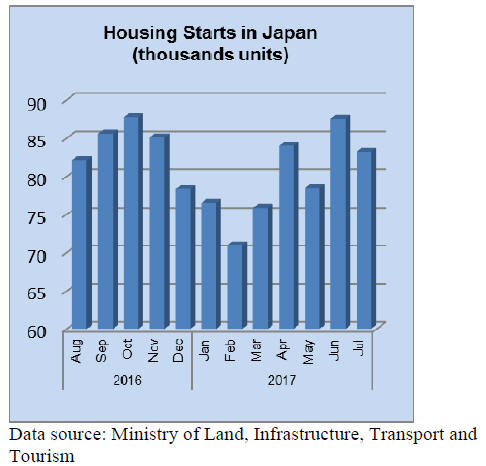
Import round up
Doors
The value of Japan’s July imports of wooden doors (HS
441820) was little changed from the previous month but
was up 25% year on year.
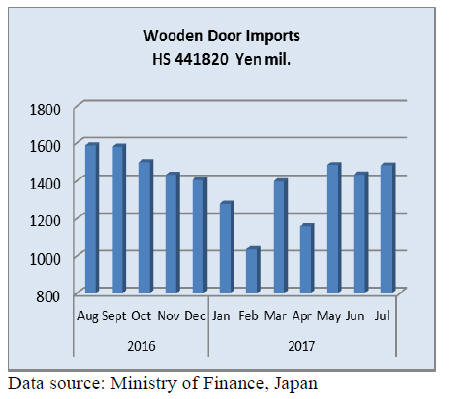
The three main suppliers in July were China (60%)
the
Philippines (19.5%) and Malaysia (8%) just topping
shipments from Indonesia.
These three have consistently topped the league of
suppliers for the past 12 months. In contrast to the
volatility in import values seen during the early part of the
year over the past 3 months the level of monthly imports
has stabilized.
Windows
Japan’s imports of wooden windows (HS 441810) in July
were 3% down year on year but largely unchanged from a
month earlier. Shippers in 3 countries dominated Japan’s
July wooden window imports, China (36%), the
Philippines (24%) and the US (24%).
Over the past 3 months wooden window imports have
gradually risen after the lows recorded at the beginning of
the year. In the first 4 months of the year wooden window
imports fell to the lowest level for the past 3 years.

Assembled flooring
The volatility in imports of assembled wooden flooring
(HS441871-79) observed in the year to-date continues.
After rising in June the value of imports fell once more in
July. However, the seesaw trend in imports has been a
feature of deliveries for several years and as such does not
indicate any particular underlying trend.
Year on year, Japan’s July assembled flooring imports
were up 7% but compared to the value of June imports
they were down 21%. The main category of assembled
flooring imports in July was HS 441875 accounting for
just over 70% of all assembled flooring imports. HS
441873 imports and HS 441879 imports were much
smaller (9% and 19% respectively). In each category
China was the main supplier.
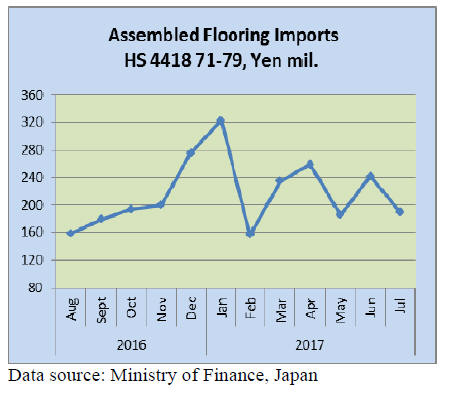
Plywood
Some 88% of Japan’s July plywood imports were recorded
as HS 441231 with the balance being HS 441233 (4%) and
HS 441234 (8%). Year on year, July imports were down
5% with July imports from China being unchanged from a
year earlier, imports from malaysia rising 8% and imports
from Indonesia dropping 24%.
In July Malaysia was the main supplier of plywood to
Japan accounting for 56% of all imports followed by
Indonesia (31%) with most of the balance coming from
manufacturers in China.
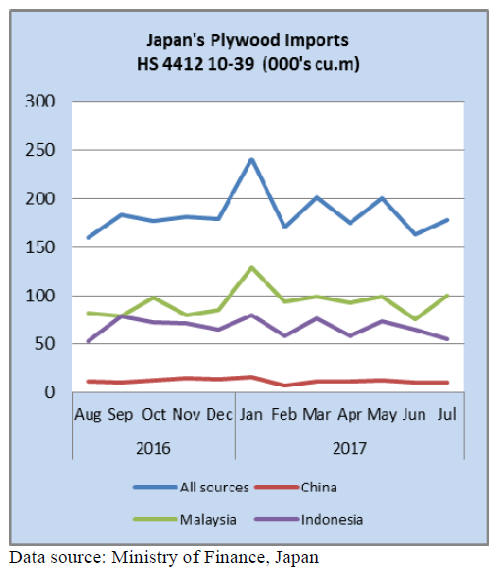 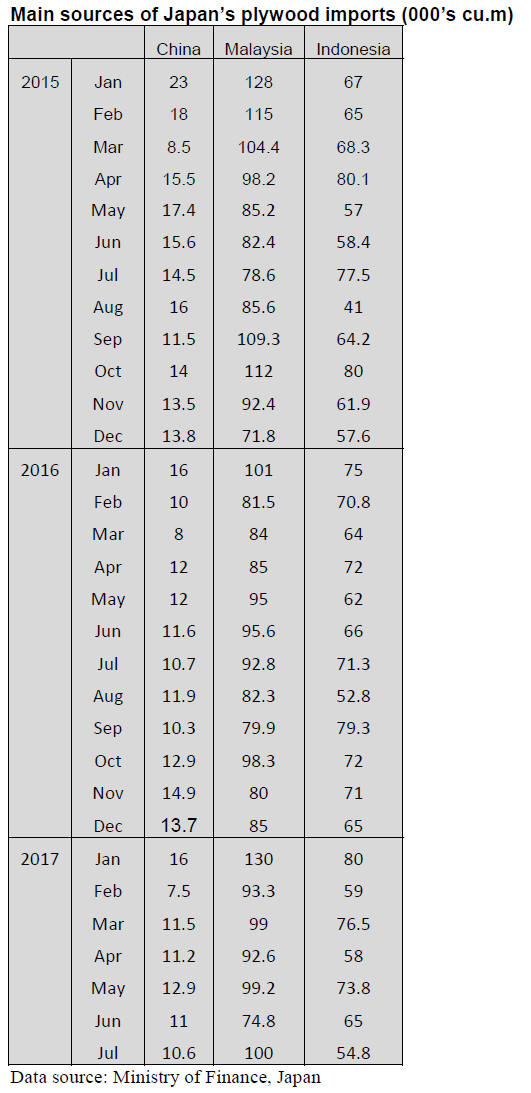
Trade news from the Japan Lumber Reports (JLR)
For the JLR report please see:
http://www.nmokuzai.
com/modules/general/index.php?id=7
South Sea (Tropical) lumber import
For the first six months of the year, import of South Sea
lumber was 235,990 cbms, 5.7% less than the same period
of last year. In this, laminated free board was 129,996
cbms, 5.1% less.
In the South East Asian countries, log procurement is
getting difficult by harvest restrictions. Indonesian lumber
manufacturers of laminated free board struggle to secure
enough logs in competition with overseas log buyers like
India and Vietnam.
Prices of Indonesian merkusii pine laminated free board
climbed to $950 per cbm C&F, which costs about 120,000
yen per cbm in Japan. Chinese red pine laminated free
board prices are also up by active economy in China.
Import volume of Indonesian free board was 47,067 cbms,
4.3% less. 14,707 cbms from Vietnam and 59,553 cbms
from China.
Hardwood lumber was 36,560 cbms, 7.2% less and
hardwood processed lumber (tongue and groove) was
56,882 cbms, 7.2% less. Rail ties were 3,336 cbms, 21.1%
less.
Wood product export in the first half of 2017
Wood products export value during January and June this
year was 15,820 million yen, 38.6% more than the same
period of last year. By destination in value, China remains
the top then Philippines increased considerably. It
increased by more than 20% to Korea.
For China market, Japanese cedar logs are more
competitive than New Zealand radiate pine logs and in
June, log export volume exceeded 100,000 cbms. For
Philippines, lumber export increased by about 30%. Total
export of plywood was 56,000 cbms out of which 90% is
gone to Philippines.
It looks like packaged export of lumber and plywood.
There is increasing share of Japanese cedar lumber
exported to Korea, which is processed in China and
Vietnam. Also precut housing materials are exported to
Korea.
New trend is lumber export to the U.S.A. The volume was
4,600 cbms, 315% more. This appears to be fence
materials in the U.S. market.
Tight supply of all types of wood panels
After supply of floor base plywood from South Sea
countries gets tight, there are structural changes in wood
panel market as floor base users try to switch to other
materials, which influences not only domestic softwood
plywood but particleboard, OSB and MDF.
Every panel manufacturers try to catch this market and
manufacture value added new products, which reduce
supply of traditional panels.
With various harvest restrictions and environmental
consideration, material log supply is getting tighter and
tighter in Indonesia and Malaysia and there are
considerable delays of arrival of ordered cargoes.
To replace hardwood to softwood, initially users had
uneasiness of quality so it took time before users decided
to use softwood plywood then since 2016, monthly
volume has been about 10,000 cbms and there are more
orders now.
For domestic plywood manufacturers, new product is
necessary with depopulation in future in Japan but in last
two years, with active housing starts, mills are busy
catching up orders of structural panels as their priority is
to satisfy needs of structural panels and the orders
continue coming in so mills have very little time to fill up
demand of floor base panels.
Currently, South Sea countries suffer foul weather and
harvest areas are further inland so log production is very
low therefore, arrivals of floor base panel are delayed by a
month or more. The prices are up and the inventories in
Japan are extremely low.
Floor manufacturers are increasing production of
composite floor of softwood plywood and thin MDF. Sales
of composite floor in the first six months of this year were
60% more than last year and particleboard floor base is
also up by 13%. This increased demand for MDF and
OSB.
Thin MDF is necessary to make composite floor but there
are only four MDF manufacturers to supply thin softwood
MDF for flooring. Also hardwood thin MDF is getting
tight by this move. Tight supply of structural plywood is
likely to stimulate demand for particleboard bearing wall.
Therefore, shifting of floor demand is causing supply
tightness of all kind of wood panel.
Plywood
Supply of domestic softwood plywood is getting tighter
again. July plywood supply was 499,000 cbms, 0.6% less
than July last year and 0.7% more than June. The supply
was below 500,000 cbms for two consecutive months. In
this, domestic softwood plywood production was 261,600
cbms while the shipments were 262,100 cbms, 4.8% more
and 0.3% less so the inventories were 93,400 cbms.
Orders had been active from direct users like
housebuilders and precutting plants as compared to dull
orders from wholesalers but since late August, orders from
wholesale channels started picking up to build up
inventories to deal with possible supply shortage in
demand busy fall season. Now deliveries delay by about a
week or two but delay does not impact actual construction
works.
Imported plywood in July was 225,200 cbms, 6.6% less
and 3.5%more. By source, 101,900 cbms from Malaysia,
6.5% more and 32.5% more, 60,600 cbms from Indonesia,
22.6% less and 17.9% less and 47,700 cbms from China,
7.9% less and 9.5% less.
Drop of Indonesian supply is considerable and supply of
thin and medium thick plywood from Indonesia is critical
and users frantically look for substitutions.
Orders rush to domestic South Sea hardwood plywood
mills but they are not able to have enough material logs.
Meantime, on coated concrete forming plywood from
Malaysia, the importers ask over 1,300 yen per sheet due
to higher cost of future arrivals but the demand continues
slow so wholesale prices are about 1,270-1,280 yen.

|